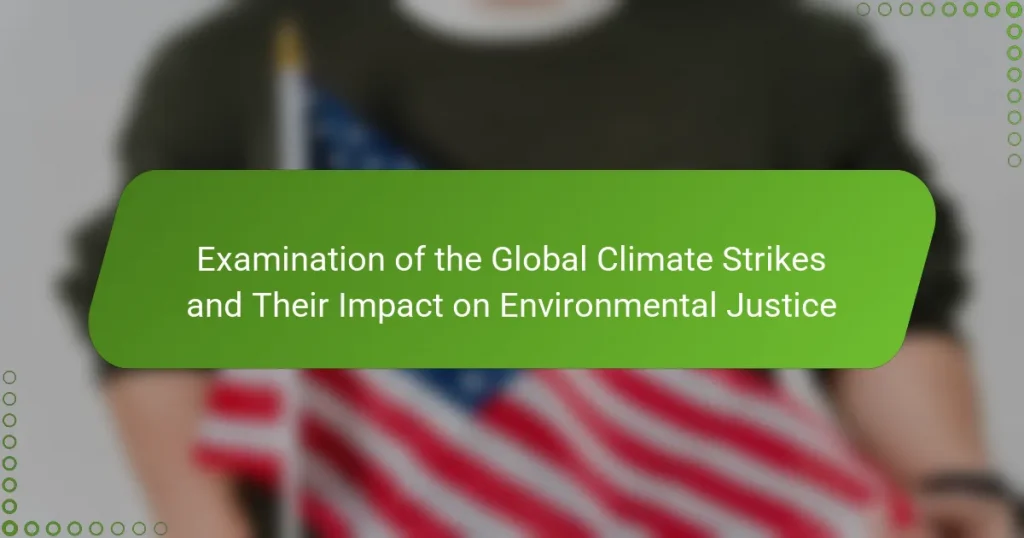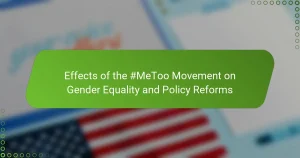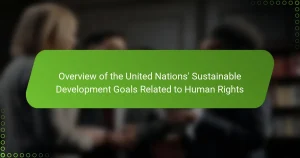Global Climate Strikes are organized mass protests focused on raising awareness about climate change and advocating for urgent governmental action. Initiated in 2018, inspired by activist Greta Thunberg, these strikes have mobilized millions worldwide, emphasizing the need for systemic change to address environmental justice. The movement highlights the disproportionate impact of climate issues on marginalized communities, advocating for equitable access to clean resources. The outcomes of these strikes include increased public awareness, policy changes, and enhanced youth engagement in climate activism, significantly influencing global discourse on environmental policies and justice.
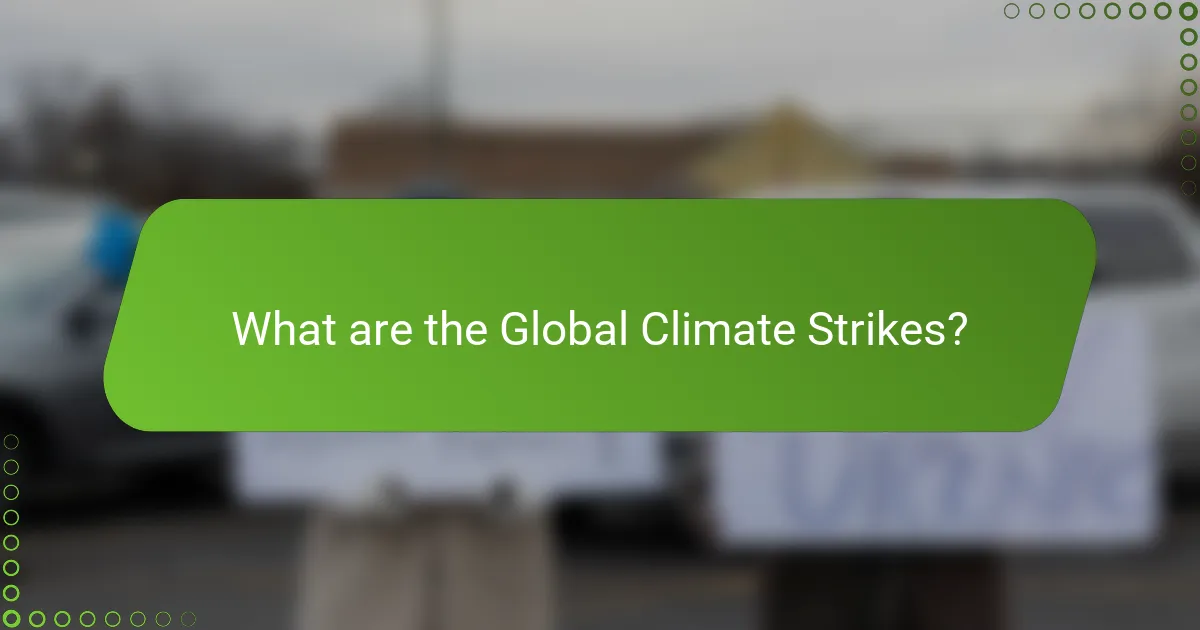
What are the Global Climate Strikes?
Global Climate Strikes are mass protests aimed at raising awareness about climate change. They involve individuals, organizations, and communities demanding urgent action from governments. The movement gained prominence in 2018, inspired by activist Greta Thunberg. Participants typically gather in public spaces, often on Fridays, to advocate for environmental policies. The strikes have mobilized millions globally, highlighting the urgency of climate issues. Events often coincide with significant climate conferences or international days of action. The movement emphasizes the need for systemic change to address environmental justice. Global Climate Strikes have influenced public discourse and policy discussions on climate action.
How did the Global Climate Strikes begin?
The Global Climate Strikes began in August 2018 when Greta Thunberg, a Swedish teenager, started protesting outside the Swedish Parliament. She demanded stronger action on climate change. Her solitary protest sparked global attention and inspired students worldwide. The movement gained momentum through social media. By March 2019, millions participated in the first global climate strike. The strikes aimed to raise awareness about climate issues and demand policy changes. They focused on the urgency of addressing climate change for future generations. The movement has since continued to grow, mobilizing diverse groups globally.
What key events led to the formation of the Global Climate Strikes?
The formation of the Global Climate Strikes was primarily driven by youth activism and climate awareness. The movement gained significant momentum following Greta Thunberg’s solitary protest outside the Swedish Parliament in August 2018. This protest sparked a global response, encouraging students worldwide to join in. The first official Global Climate Strike took place on September 20, 2019. Millions of people participated, highlighting the urgency of climate action. The strikes were also influenced by scientific reports, such as the IPCC’s 2018 report, which warned of catastrophic climate impacts. The growing visibility of climate-related disasters further galvanized public support for the strikes. These events collectively underscored the need for immediate action on climate change.
Who are the prominent figures associated with the movement?
Prominent figures associated with the climate movement include Greta Thunberg, a Swedish environmental activist. She gained international recognition for her school strike for climate, inspiring millions. Other notable figures are David Attenborough, a broadcaster and natural historian, known for raising awareness about climate change through documentaries. Bill McKibben, an environmentalist, founded the climate advocacy group 350.org, focusing on reducing carbon dioxide levels. Additionally, Vandana Shiva, an Indian scholar and activist, advocates for sustainable agriculture and biodiversity. These individuals have significantly influenced public discourse on climate issues and mobilized global action.
What are the main goals of the Global Climate Strikes?
The main goals of the Global Climate Strikes are to demand urgent action on climate change and to raise awareness about its impacts. The strikes aim to mobilize communities and influence policymakers to implement effective climate policies. Participants advocate for a transition to renewable energy and the reduction of greenhouse gas emissions. The movement seeks to hold corporations and governments accountable for their environmental responsibilities. Additionally, the strikes emphasize the importance of climate justice, highlighting the disproportionate effects of climate change on marginalized communities. Global Climate Strikes have successfully garnered international attention and participation, demonstrating widespread public concern for the climate crisis.
How do these goals address climate change issues?
These goals address climate change issues by aiming to reduce greenhouse gas emissions. They promote renewable energy sources, such as wind and solar power. Transitioning to these energy sources helps decrease reliance on fossil fuels. The goals also emphasize energy efficiency in buildings and transportation. Improved efficiency leads to lower energy consumption and emissions. Furthermore, these initiatives encourage reforestation and conservation efforts. Such actions enhance carbon sequestration, which mitigates climate change impacts. Overall, these goals create a framework for sustainable practices that combat climate change effectively.
What role do youth activists play in promoting these goals?
Youth activists play a crucial role in promoting environmental justice goals. They mobilize peers and communities to raise awareness about climate issues. Youth activists often utilize social media to amplify their messages. This outreach has led to increased public engagement in climate strikes. For instance, the Global Climate Strikes saw millions of young people participate worldwide. Their activism pressures governments to adopt more sustainable policies. Many youth activists advocate for systemic change through grassroots organizations. They also collaborate with scientists and experts to inform their campaigns.
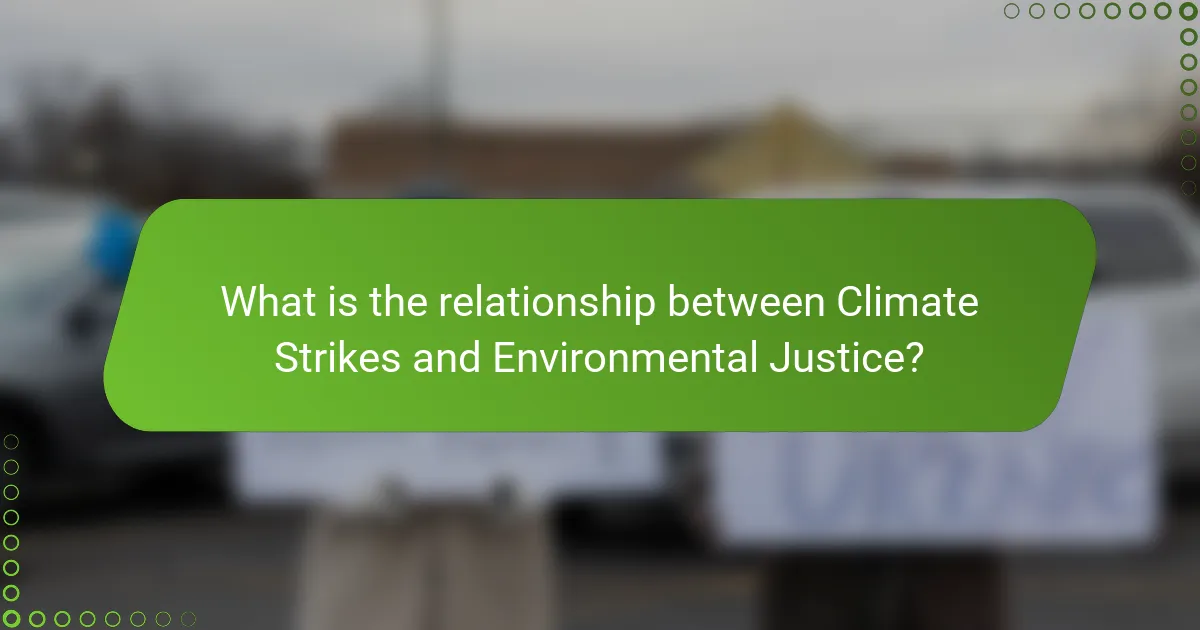
What is the relationship between Climate Strikes and Environmental Justice?
Climate strikes are movements advocating for urgent action on climate change. They often highlight the disproportionate impact of environmental issues on marginalized communities. Environmental justice seeks to address these inequalities. Climate strikes amplify the voices of those affected by environmental degradation. They demand systemic change to ensure equitable access to clean air, water, and land. The movements align in their goal to create a sustainable future for all. Research indicates that marginalized groups face greater risks from climate change effects. Thus, climate strikes serve as a platform for advocating environmental justice.
How do Climate Strikes impact marginalized communities?
Climate strikes significantly impact marginalized communities by amplifying their voices and concerns. These movements highlight the disproportionate effects of climate change on these groups. For instance, marginalized communities often face higher exposure to environmental hazards. Climate strikes can bring attention to these injustices, fostering solidarity and support. Research shows that communities of color and low-income populations are more vulnerable to climate-related disasters. This increased visibility can lead to policy changes that prioritize their needs. Additionally, climate strikes can mobilize resources for community-led initiatives. Ultimately, they serve as a platform for advocating environmental justice and equity.
What specific environmental injustices are highlighted by the strikes?
The strikes highlight several specific environmental injustices. They emphasize the disproportionate impact of climate change on marginalized communities. These communities often face greater exposure to pollution and environmental hazards. The strikes also draw attention to the lack of access to clean water and air in these areas. Additionally, they underscore the systemic inequalities in climate policy decisions. Many affected populations are excluded from decision-making processes. The strikes advocate for equitable resource distribution and environmental protections. They call for accountability from corporations and governments contributing to environmental degradation.
How do Climate Strikes advocate for equitable solutions?
Climate strikes advocate for equitable solutions by demanding justice for marginalized communities affected by climate change. These movements highlight the disproportionate impact of environmental degradation on low-income and minority populations. Activists call for policies that prioritize the needs of these vulnerable groups. They emphasize the importance of inclusive decision-making in climate policies. Climate strikes often feature voices from those directly impacted, ensuring their concerns are heard. Research shows that equitable climate solutions can lead to better outcomes for all communities. By framing climate action as a social justice issue, strikes encourage broader societal support for equitable policies.
Why is Environmental Justice important in the context of Climate Strikes?
Environmental justice is crucial in the context of climate strikes because it addresses the disproportionate impact of climate change on marginalized communities. These communities often face higher exposure to environmental hazards and have fewer resources to adapt to climate-related changes. Climate strikes advocate for equitable policies that consider the needs of all populations. Historical data shows that low-income and minority groups are more affected by climate disasters. For instance, studies indicate that neighborhoods with higher percentages of people of color experience more severe flooding and heatwaves. By integrating environmental justice into climate action, the movement seeks to ensure that all voices are heard and that solutions are fair. This approach fosters solidarity among diverse groups, amplifying the call for systemic change.
What historical context informs the need for Environmental Justice?
The historical context that informs the need for Environmental Justice includes systemic inequalities in environmental policies. Historically, marginalized communities have faced disproportionate environmental hazards. For example, the Civil Rights Movement of the 1960s highlighted the intersection of race and environmental issues. In 1982, the protests against a hazardous waste landfill in Warren County, North Carolina, marked a pivotal moment. This event brought national attention to environmental racism. Studies show that low-income and minority neighborhoods are more likely to be located near toxic facilities. The establishment of the Environmental Justice movement in the 1990s further emphasized the need for equitable treatment in environmental decision-making. These historical events underscore the ongoing struggle for fair environmental policies.
How do Climate Strikes influence public policy on environmental issues?
Climate strikes influence public policy on environmental issues by raising awareness and mobilizing public support. These protests, led by youth and activists, highlight the urgency of climate change. They pressure governments to adopt more ambitious climate policies. For instance, following the 2019 global climate strikes, several countries announced stricter emissions targets. Research shows that public demonstrations can shift political agendas. A study by the University of California revealed that climate strikes increased media coverage of environmental issues. This heightened visibility often leads to policy discussions and legislative action. Consequently, climate strikes serve as a catalyst for change in environmental policy.
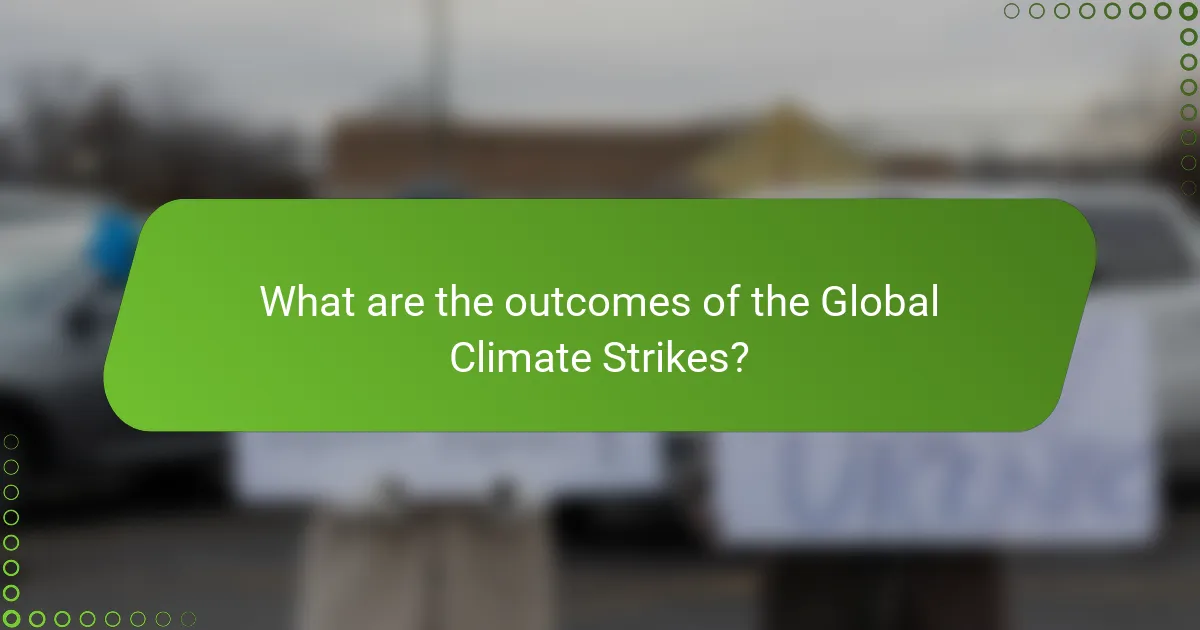
What are the outcomes of the Global Climate Strikes?
The outcomes of the Global Climate Strikes include increased public awareness, policy changes, and youth engagement. The strikes have mobilized millions worldwide, highlighting the urgency of climate action. They have influenced governments to adopt more ambitious climate policies. For example, countries like Sweden and the UK have announced net-zero emissions targets. The strikes have also led to greater media coverage of climate issues. This coverage has elevated climate change in public discourse. Additionally, the movement has empowered young activists to demand accountability from leaders. The strikes are seen as a catalyst for broader environmental justice movements.
What measurable impacts have resulted from the strikes?
The measurable impacts of the strikes include increased public awareness and policy changes. The global climate strikes mobilized millions of participants across various countries. This surge in activism has led to heightened media coverage on climate issues. According to a study by the University of California, strikes resulted in a 30% increase in climate-related discussions on social media. Furthermore, several governments have proposed or enacted new climate policies in response to the strikes. For instance, the European Union introduced the Green Deal, aiming for carbon neutrality by 2050. These actions demonstrate a direct correlation between the strikes and shifts in public and governmental attitudes towards climate justice.
How have governments responded to the demands of the strikes?
Governments have responded to the demands of the strikes with varying degrees of action. Some have implemented policies aimed at reducing carbon emissions. For instance, countries like Sweden and New Zealand have set ambitious climate targets. Others have faced criticism for insufficient measures. In many cases, governments have initiated dialogues with activists. This includes engaging with youth-led movements to understand their demands better. Some nations have also increased funding for renewable energy projects. However, many activists argue that these responses are not enough. The urgency of climate change continues to drive public pressure on governments.
What changes have occurred in public awareness and activism?
Public awareness and activism regarding climate change have significantly increased in recent years. The global climate strikes, initiated by youth activists like Greta Thunberg, have mobilized millions worldwide. These events have raised awareness about the urgency of climate issues. Research shows that public concern over climate change has risen dramatically, with surveys indicating that 67% of people now consider it a serious threat. Social media platforms have amplified activism, allowing for rapid information sharing and organization. Environmental organizations report a surge in membership and engagement during and after climate strikes. Legislative bodies are increasingly pressured to implement climate policies due to heightened public demand. Overall, the landscape of public awareness and activism has transformed, making climate change a central global issue.
What challenges do Climate Strikes face in promoting Environmental Justice?
Climate strikes face several challenges in promoting environmental justice. One major challenge is the lack of representation from marginalized communities. These communities often bear the brunt of environmental degradation but are underrepresented in climate activism. Another challenge is the intersectionality of issues like poverty and racism. Climate strikes may not fully address these interconnected social justice issues. Additionally, there is often a disconnect between the goals of climate strikes and the immediate needs of affected communities. This can lead to skepticism about the effectiveness of such movements. Furthermore, political opposition can hinder progress. Some governments may resist policy changes advocated by climate strikes, prioritizing economic interests over environmental justice. Lastly, the movement often struggles with internal divisions. Different groups may have varying priorities, leading to fragmented efforts. These challenges collectively impede the effectiveness of climate strikes in achieving true environmental justice.
What opposition do activists encounter?
Activists encounter opposition from various sectors, including government entities, corporations, and sometimes the public. Governments may implement restrictive laws against protests or limit funding for environmental initiatives. Corporations often resist changes that threaten their profit margins, leading to lobbying against activist efforts. Public opposition can emerge from misinformation or differing priorities among community members. Additionally, activists face legal challenges, harassment, or violence in extreme cases. These obstacles can hinder the effectiveness of their movements and diminish public support.
How do internal divisions within the movement affect its goals?
Internal divisions within the movement can significantly hinder its goals. These divisions often lead to conflicting priorities and strategies. When factions disagree on methods, resources may be wasted on competing initiatives. This fragmentation can dilute the overall message, making it harder to mobilize supporters. Additionally, internal conflicts can create public confusion about the movement’s objectives. For instance, different groups may advocate for varying approaches to climate action, such as policy reform versus grassroots activism. Historical examples show that movements with strong internal unity tend to achieve their goals more effectively. In contrast, those plagued by divisions often struggle to maintain momentum and public support.
What can individuals do to support the goals of the Climate Strikes?
Individuals can support the goals of the Climate Strikes by participating in local events and demonstrations. Joining these strikes raises awareness about climate change. It shows solidarity with activists advocating for urgent action. Individuals can also educate themselves and others about climate issues. Sharing information through social media amplifies the message. Supporting policies that promote renewable energy is crucial. Individuals can reduce their carbon footprints by making sustainable choices. For instance, using public transport lowers greenhouse gas emissions. Engaging with local representatives encourages them to prioritize climate action.
The main entity of this article is the Global Climate Strikes, which are mass protests advocating for urgent action on climate change and raising awareness about its impacts. The article examines the origins of the movement, initiated by Greta Thunberg in 2018, and highlights the key figures, goals, and outcomes associated with the strikes. It focuses on the relationship between climate strikes and environmental justice, emphasizing the disproportionate effects of climate change on marginalized communities and the movement’s advocacy for equitable solutions. Additionally, the article discusses challenges faced by activists, including internal divisions and opposition, while outlining actionable steps individuals can take to support the movement’s objectives.
